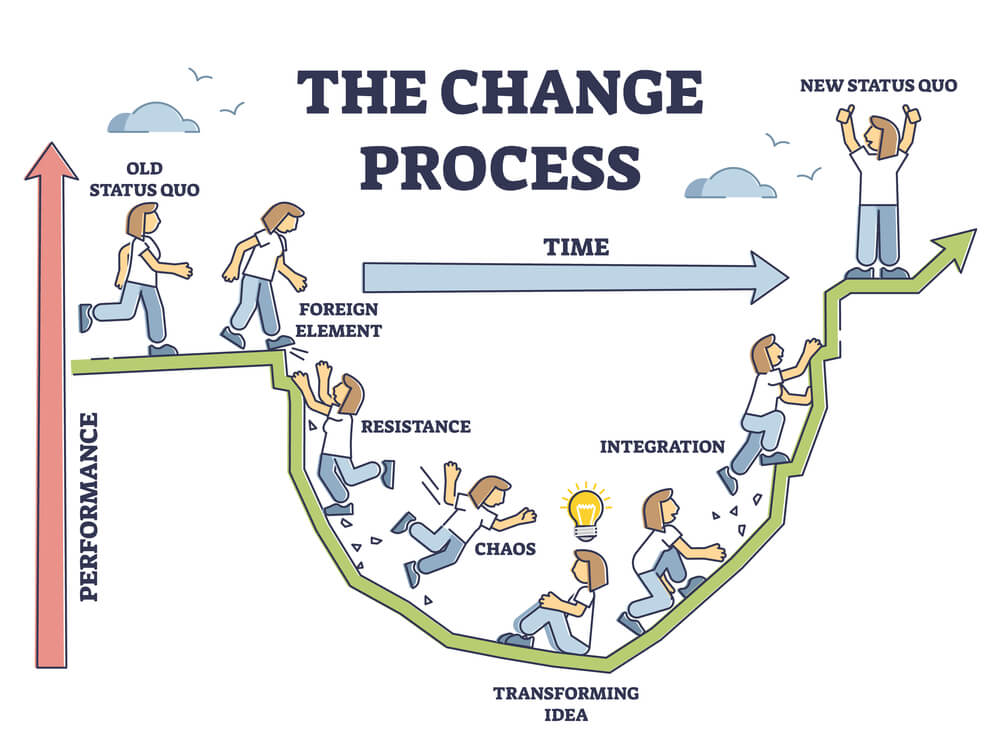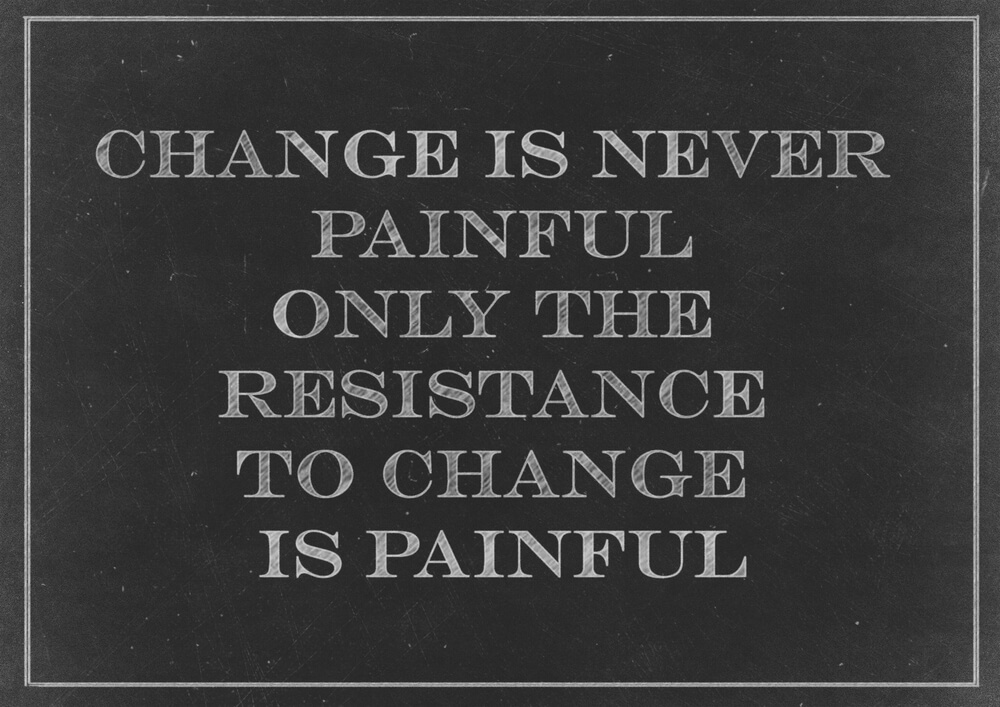
Change is hard. We square up and are ready to fight when any change threatens our status quo. Will you be curious and still, long enough to think before you react? Even if things are simple, they are not easy. What if we stopped looking at change as the enemy and look at the possibilities the change will allow us to have? It’s a process. Give yourself permission to change along with the grace to move forward.
If you’re looking to make changes to your lifestyle for health reasons, it’s important to be prepared for resistance. Whether from others or within yourself, resistance to change can be one of the biggest obstacles to achieving your health goals. However, there are several tips you can follow to help overcome this resistance and make lasting changes to your health habits.
One of the most important things you can do is to set clear and realistic goals. This will help you stay focused and motivated and give you a sense of accomplishment as you reach each milestone. It’s also important to have a support system in place, whether it’s friends and family or a professional coach or counselor. This can help you stay accountable and provide encouragement when you’re feeling discouraged. Think SMART Goals – Specific, Measurable, Attainable, Realistic, & Timely.
Another key to decreasing your resistance to change is to be patient with yourself. Change takes time, and setbacks are inevitable. However, it’s important to stay positive and keep moving forward. Remember that every small step you take towards your health goals is a step in the right direction and that every day is a new opportunity to make positive changes in your life. Progress over perfection.
It is important to understand that resistance to change is a natural and normal response to change. We talked about that in the last post. However, it is also important to recognize when resistance to change is preventing you from making positive changes to your health. What is really stopping you? Fear of failure. Fear of the unknown. Feeling that you aren’t worthy? You don’t really know where to begin or how to start?
Health Benefits of Embracing Change
Increased Longevity
Embracing change can lead to increased life span and even better health. Studies have shown that individuals who are open to change are more likely to live longer and healthier lives. This is because change often leads to new opportunities, experiences, and challenges that keep the mind and body active and engaged. Our bodies are made to move.
In addition, embracing change can help you develop a more positive outlook on life. When you are open to new experiences, you are more likely to see the world as full of possibilities rather than limitations. This can lead to a more optimistic and hopeful attitude, which has been linked to better health outcomes. I get it. I am saying to embrace change you are back at decreasing resistance. You do have to decrease your resistance to change before you can embrace change.
Improved Mental Health
Reducing resistance to change can also have a positive impact on your mental health. When you are open to new experiences, you are less likely to feel stuck or trapped in your current situation. This can help reduce feelings of anxiety, stress, and depression.
In addition, embracing change can help you develop resilience and coping skills. When you encounter challenges or setbacks, you are better equipped to adapt and overcome them. This can help you feel more confident and in control of your life. If you are a caregiver or care partner, you sure do need these positive benefits, don’t you?
Overall, embracing change can have a number of health benefits. By staying open to new experiences and opportunities, you can increase your longevity, improve your mental health, and develop resilience and coping skills. So next time you are faced with a change, try to approach it with an open mind and a positive attitude. You may be surprised at the positive impact it can have on your health and well-being. Be curious about doing things differently. Learn to “let it go.” I couldn’t do that until I learned what that really meant. Letting it go means to “let it be, just as it is, right now.” I had to learn to do things with no attachment to the outcome. I prepare, implement and readjust as needed, but I cannot control the outcome.
Practical Tips for Overcoming Resistance
Dealing with resistance to change can be a challenging task, especially when it comes to health-related changes. However, with the right mindset and approach, you can overcome resistance and achieve your health goals. Here are some practical tips to help you overcome resistance to change. If you are a caregiver, you must maintain your own health or you will not be able to be a good caregiver for very long.
Embrace a Positive Mindset
The first step to overcoming resistance to change is to embrace a positive mindset. Instead of focusing on the negative aspects of change, focus on the positive outcomes that you will achieve. Visualize yourself achieving your health goals and imagine how good it will feel to be healthier. This positive mindset will help you stay motivated and overcome any resistance that you may encounter. Understand that willpower alone will not make you successful. Sometimes, you have to make a decision and do it, no matter how you feel. Do it, consistently, and soon it will become a habit that you don’t have to think about.
You have to look towards your future self. Look three months down the road. What are you doing? How are you feeling now that you are progressing? What benefits are you seeing? How much stronger are you both physically and mentally?
Set Realistic Goals
Setting realistic goals is another important step in overcoming resistance to change. When you set unrealistic goals, you are setting yourself up for failure, which can lead to resistance. Instead, set achievable goals that are within your reach. For example, if your goal is to lose weight, start with a small goal of losing 1 pound each week. As you achieve these small goals, you will build momentum and be more likely to achieve your larger goals. Walk for 10-15 minutes 5 days a week.
Seek Professional Help
Sometimes, overcoming resistance to change can be difficult on your own. If you are struggling to make changes to your health, seek professional help. A healthcare professional can provide you with the guidance and support that you need to overcome resistance and achieve your health goals. They can also help you create a personalized plan that is tailored to your specific needs.
Hire a trainer for a few sessions. Find a buddy to walk with or to help keep each other accountable and encourage each other.
Incorporating Healthy Lifestyle Changes
When it comes to improving your health, making lifestyle changes is key. Incorporating healthy habits can be challenging, but it’s important to remember that small changes can make a big difference. Here are some tips for incorporating healthy lifestyle changes that can help you overcome resistance to change:
Dietary Changes
Changing your diet can be one of the most challenging lifestyle changes to make, but it’s also one of the most important. Here are some tips for making dietary changes:
- Start small: Make small changes to your diet, such as swapping out unhealthy snacks for healthier options.
- Plan ahead: Plan your meals and snacks in advance to avoid making unhealthy choices when you’re hungry.
- Keep it balanced: Make sure your diet includes a balance of fruits, vegetables, whole grains, lean proteins, and healthy fats.
- Seek support: Consider joining a support group or working with a registered dietitian to help you make healthy dietary changes.
- Carbohydrates 40 – 45 gm at each meal
- Drink your water every day. (about half your body weight in ounces of water per day)
Exercise and Physical Activity
Regular exercise and physical activity can help improve your overall health and reduce your risk of chronic diseases. Here are some tips for incorporating exercise and physical activity into your daily routine:
- Start small: Begin with small amounts of physical activity, such as taking a short walk or doing some light stretching.
- Find activities you enjoy: Choose activities that you enjoy, such as dancing, hiking, or swimming, to make exercise more fun.
- Make it a habit: Schedule physical activity into your daily routine to make it a regular habit.
- Seek support: Consider working with a personal trainer or joining a fitness class to help you stay motivated.
Stress Management
Stress can have a negative impact on your health, so it’s important to find healthy ways to manage stress. Here are some tips for managing stress:
- Practice relaxation techniques: Try relaxation techniques such as deep breathing, meditation, or yoga to help reduce stress.
- Stay organized: Keeping a to-do list and staying organized can help reduce stress and make it easier to manage your daily tasks.
- Get enough sleep: Getting enough sleep is important for reducing stress and improving overall health.
- Seek support: Consider talking to a therapist or joining a support group to help you manage stress.
Remember, making lifestyle changes takes time and effort, but the benefits to your health are worth it. Start small, seek support, and stay motivated to make healthy changes that will improve your overall health and well-being.
Long-Term Strategies for Maintaining Change
Consistency is Key
One of the most important factors in maintaining long-term change is consistency. Once you have made changes to your lifestyle for health reasons, it is essential that you stick to them. This can be challenging, especially if you are used to a certain way of living, but it is crucial for your health and well-being.
To help you stay consistent, consider creating a schedule or routine that includes time for exercise, meal planning, and other healthy habits. This can help you stay on track and make it easier to stick to your new habits. What gets written down, gets done.
Regular Health Check-Ups
Regular health check-ups are also crucial for maintaining long-term change. This can help you monitor your progress and identify any potential health issues early on. It is recommended that you schedule regular check-ups with your doctor or healthcare provider at least once a year.
During these check-ups, your healthcare provider can help you develop a personalized plan to maintain your health and well-being. They can also provide you with valuable information and resources to help you stay on track. If they don’t bring it up, you bring it up. Ask for the help that you need.
Would you benefit from talk therapy? Most people will. Set up a few sessions and see how you are feeling and doing. Shoot, you can even work on decreasing your resistance to change. Learn coping skills to deal with your stress in a healthier manner. Build your resilience for tough times.
Join Support Groups
Joining a support group can also be helpful for maintaining long-term change. Support groups provide a sense of community and can help you stay motivated and accountable. They can also provide you with valuable tips, advice, and resources for maintaining your health and well-being.
Consider joining a support group that focuses on your specific health concerns or goals. This can help you connect with others who are going through similar experiences and provide you with the support you need to maintain your healthy habits.
In summary, maintaining long-term change for health reasons requires consistency, regular health check-ups, and support from others. By incorporating these strategies into your lifestyle, you can stay on track and achieve your health and wellness goals.





